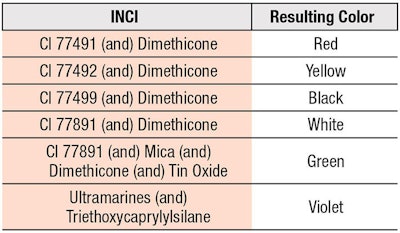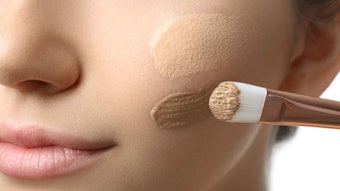
Foundations are the most commonly used decorative cosmetics on the market, and a natural-looking finish is one of their most preferred performance attributes. This puts the pressure on product developers to better match consumer skin tones;1-3 and the process of color-matching foundations true to skin is a challenge. This is due, in part, to the different biological factors defining skin color. These must be transposed into the correct blend of cosmetic pigments, which defines the color of the foundation.
Internal market research has demonstrated that in the United Kingdom, the range of cosmetic foundations available for dark skin tones, i.e., Fitzpatrick types V and VI, is considerably disproportionate to the range of products available for lighter skin tones, i.e., Fitzpatrick types I and II. In fact, of a total of 343 foundation shades observed in mainstream retailers, only 9% were suitable for consumers with dark skin. This compared with 67% for lighter skin tones.
Furthermore, consumers having darker skin tones report being dissatisfied with commercially available foundations, meaning their needs are not being met by the cosmetics industry. In relation, this study focused on the development of a foundation to effectively match a range of black skin tones. New pigments were tested in varying ratios and in vivo color measurements were made, as described here.
Materials and Methods
Pigments: Surface-treated pigments (see Table 1) were blended in different ratios and incorporated into a w/si foundation (see Formula 1) at 5% w/w to produce a range of dark-colored shades. Guidelines provided by UK-based pigment suppliers initially were used to balance the ratio of pigments. The base formulation was created by mixing white pigment (TiO2) with yellow, red and black iron oxides to create a given skin tone. Pigment levels were then increased, decreased, removed or added (e.g., violet and green) to blend pigments to match the skin tones of test subjects. Eighteen total pigment blends were created (see Table 2) and formulated into the w/si foundation base, referred to as samples FDT001 through FDT018.
In vivo and in vitro analysis: Skin melanin levels were assesseda and the CIELCh coordinates of lightness (L), chroma (C) and hue (h) values were measured by a spectrophotometerb on six facial sites of the test subjects.
Furthermore, once the 18 pigment blends were created and incorporated into formulas, they also were assessed for color; in vitro wet and dry color measurements were taken using hiding power chartsc and their in vivo efficacy evaluation was performed by color measurements before and after foundation application to the subjects.
High-resolution, full face images also were takend with and without the formulated foundations for self-evaluation by the participants. All data was statistically analyzede.
White, yellow, red and black pigments can produce a range of skin color shades. However, to create darker tones, violet and green pigments were required.
Experimental Design
A group of female study participants (n = 10) of black ethnicity (Fitzpatrick phototypes V and VI) was recruited. As noted, melanin and baseline skin color measurements were taken for each subject on six designated areas of their faces—medial left and right on the forehead, and upper and lower left and right sides of the cheeks. On each site, three readings were taken and averaged. Subjects with similar melanin and skin color values were then selected (n = 6), and average L*C*h* values (± 10%) of the selected subjects were used to formulate a range of foundation shades.
Different pigment blends were prepared and incorporated into the w/si foundation to match the skin color of the subjects. Wet and dry in vitro color measurements were taken. Continuous versions of the formula were created and tested until wet and dry in vitro L*C*h* values fell within the baseline range. Formulations fitting within the range were further tested by in vivo color measurements.
As noted, full facial images were taken before and after foundation application and volunteers were asked to complete a questionnaire. The data was statistically analyzede using softwaref; all statistical analysis was performed at a 5% level of significance.
In vivo Skin Color Analysis
Skin melanin levels were used to group volunteers with similar melanin content. For the purpose of this study, only data from subjects with a melanin level > 90 were used for L*C*h measurements (see Figure 1a, Figure 1b and Figure 1c). The average was taken for L*C*h* values of each of the six facial sites across all the selected volunteers (see Figure 1b). These six sets of L*C*h* mean values were used to calculate a guidance range (± 10%) of L*C*h* coordinates to formulate toward when making the pigment blends (see Figure 1c).
Color-matching Foundations
The combination of white, yellow, red and black pigments can produce a range of skin color shades. However, to create darker skin tones, violet and green pigments were required (see Table 2). Figure 2a, Figure 2b and Figure 2c provide an overview of the wet and dry color measurements for each prototype (FDT001-FDT018).
L* values: The L* values of the frame formulation (FDT001) were exceedingly high for both wet and dry samples. As a result, the percentage of TiO2 was gradually reduced from 78%, to being completely removed in order to decrease the L* value and make the color darker. Since the amount of TiO2 in the formulation was decreased, other pigments had to be increased, especially the darker pigments. The black pigment was increased from around 2% to 20% in the final formulation. This provided L* values for all foundations within the guidance range for wet measurements, excluding FDT017 and FDT018 (see Figure 2a). The dry L* value decreased too low to be within the guidance range in samples FDT001 to FDT005. However, the L* fell within the guidance range from samples FDT010 through FDT018.
C* values: Reducing the amount of TiO2 affected the C* value in samples FDT001 and FDT002. The decreased amount of white pigment increased C*, resulting in a more vibrantly colored foundation. However, this C* value was too high for the guidance range.
The violet pigment was added to the formulation at 7.5% in sample FDT003 and 14% in sample FDT004, in attempt to decrease the C* value and cause the foundation to appear duller. A large decrease in C* was observed for both samples. C* values also increased in samples FDT010 through FDT012 due to higher levels of the purple pigment (27-29%). From samples FDT013 to FTD018, with < 24% purple pigment, the C* values remained within the guidance range.
h* values: The h* values decreased from samples FDT001 to FDT004. Then, a large increase was observed from samples FDT004 through FDT010, where it eventually decreased and stayed within the guidance range. Increasing the h* value corresponds with making the foundation more yellow, and decreasing it will make the foundation appear redder.
Initially, green pigment was added to the blend in an attempt to increase the h* value, which it did, although the level of green pigment was too high and dispersing high levels of this pigment was challenging due to the fact it cannot be ground. By modifying levels of red and yellow pigments, however, the h* values were brought within the guidance range.
As a final result, formulas FDT016, FDT017 and FDT018 were within the guidance L*C*h* range and were presented to the subjects.
Further research is necessary to produce better coverage of minor skin imperfections without impacting the overall natural-looking product color.
In vivo Efficacy of Prototypes
The volunteers who provided the guidance baseline L*C*h* range applied the prototype shade they believed best matched the tone of their skin, from samples FDT016 through FDT018. Before and after foundation application, the L*C*h* readings were taken on the six sites of the face. In addition, full face images were taken and participants were required to complete a self-evaluation questionnaire.
In Figure 3a, Figure 3b and Figure 3c, the average L*C*h* values before and after foundation application are shown. No significant differences were observed for L*, C* or h* values before and after foundation application, indicating the foundations matched the color of subjects’ skin.
Participants were asked to rate the functionality of the tested formulations, scoring on a scale from 1-10 whether they strongly agreed (10) or strongly disagreed (1) with five statements. Figure 4 shows the participants strongly agreed that the foundation matched and unified their skin tone; however, participants were not satisfied with the coverage.
Participants also were asked which full face image (data not shown) they preferred from options including: baseline, with no foundation application; post- foundation application using their own foundation; and post-foundation application using the test foundation. All participants selected the image with their own foundation as the preference, while 80% selected the test foundation as their second choice. In addition, 80% stated their least preferred image was the one without foundation.
It is speculated the subjects preferred their own foundation due to the insufficient coverage provided by the formulated foundation; hence, it was unable to mask skin imperfections.
Conclusion
This study explored a novel approach to develop cosmetic foundations that effectively match black skin tones. This process involved the formulator first establishing a baseline L*C*h* combination, as a guidance, which was then matched by iteratively changing the type and level of pigments, based on the information obtained from the L*C*h* measurements of each prototype. The in vitro and in vivo findings of this study suggest it is possible to formulate successful color-matched foundations using the above approach. However, further research is necessary in terms of producing better coverage of minor skin imperfections without impacting the overall skin color.
Acknowledgements: The authors wish to acknowledge the technical assistance of Senait Tewolde and Carmel Lally.
References
- http://academic.mintel.com (Accessed March 18, 2015)
- http://academic.mintel.com (Accessed Nov 18, 2013)
- www.koboproductsinc.com/downloads (Accessed Mar 30, 2015)
Additional Reading:
dawsonera.com/readonline
ML Schlossman, ed, The Chemistry and Manufacture of Cosmetics, 2, 4th edn, Allured Business Media, Carol Stream, IL USA (2009)













